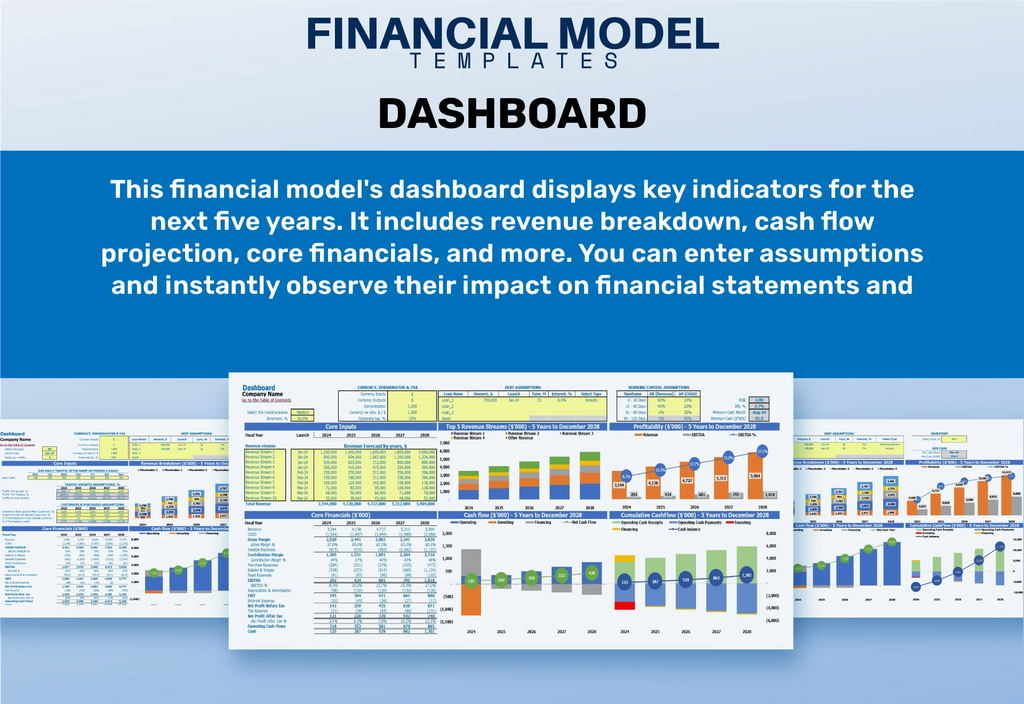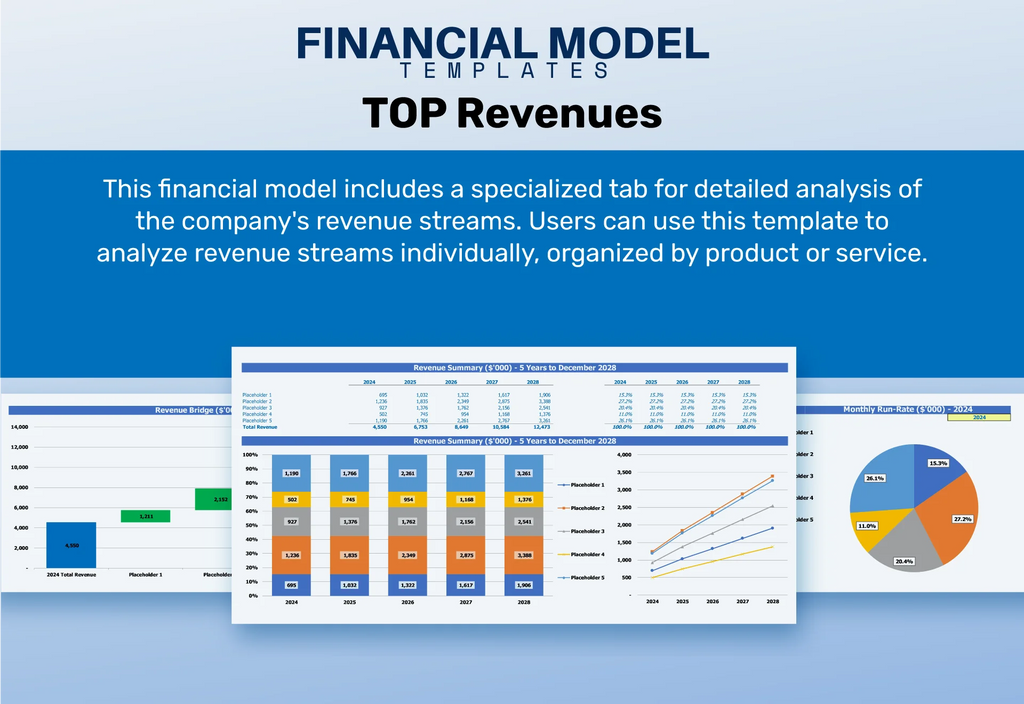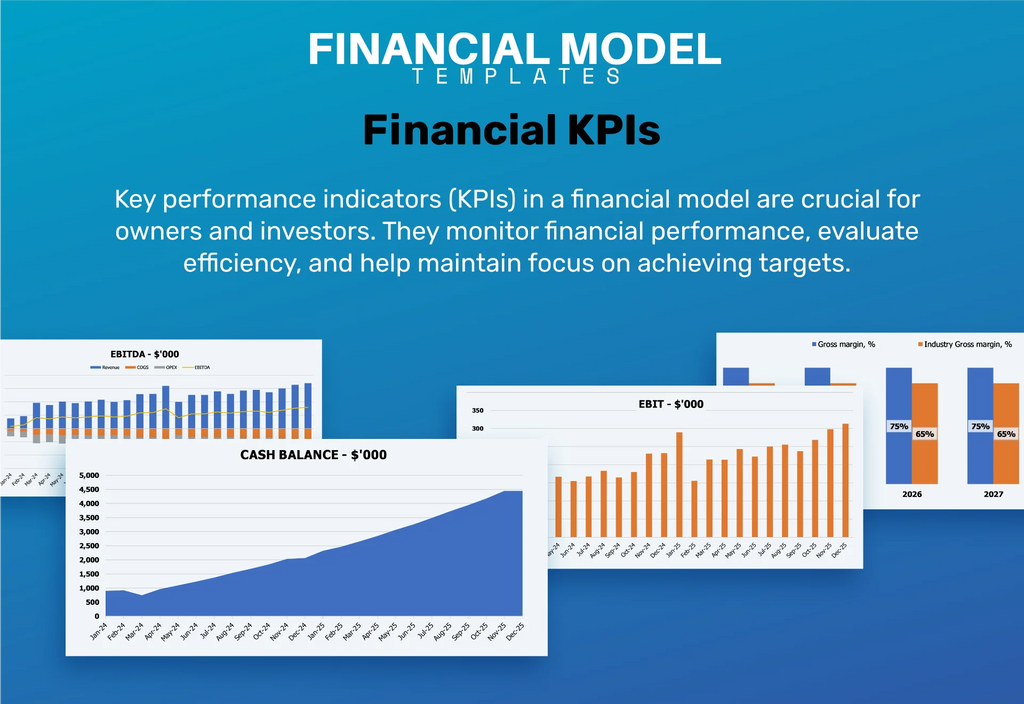Warehousing Distribution Financial Model

- ✔ 5-Year Financial Projections
- ✔ 100% Editable
- ✔ Investor-Approved Valuation Models
- ✔ MAC/PC Compatible, Fully Unlocked
- ✔ No Accounting Or Financial Knowledge
Warehousing Distribution Financial Model
Bundle Includes:
ALL IN ONE MEGA PACK - CONSIST OF:
warehousing distribution Financial Model/Business Plan Excel Template
Pitch Deck Template For PowerPoint, Keynote & Google Slides
Business Plan Guide and Business Plan Template in MS Word Format
Financial Dashboard in Excel To Track Your Business Performance
WAREHOUSING DISTRIBUTION FINANCIAL MODEL FOR STARTUP INFO
Highlights
The warehousing distribution financial analysis template is a comprehensive 5-year financial model tailored for businesses in the warehousing distribution sector, ideal for both startups and established operations. This tool is designed to optimize the distribution cost structure while providing valuable insights into logistics expense forecasting and transportation cost analysis. By integrating inventory management models and evaluating warehouse operating expenses, users can enhance distribution center profitability and efficiently manage warehouse capacity planning. Additionally, the template supports supply chain finance strategies, enabling effective inventory turnover ratio assessments and operational efficiency metrics to streamline financial modeling for logistics and improve overall supply chain optimization.
The ready-made financial model in Excel addresses key pain points faced by buyers in warehousing and distribution by providing comprehensive tools for logistics expense forecasting and transportation cost analysis, ensuring effective management of warehouse operating expenses while enhancing distribution center profitability. It streamlines inventory management with an inventory turnover ratio reflection, supports warehouse capacity planning, and offers a robust supply chain finance framework tailored to individual business needs. Furthermore, the model aids in operational efficiency metrics tracking, enabling better decision-making in supply chain optimization and risk management, ultimately leading to improved warehouse asset utilization and a more sustainable distribution cost structure.
Description
A robust logistics financial model is essential for entrepreneurs entering the warehousing distribution sector, as it provides a comprehensive framework for financial analysis, including transportation cost analysis and inventory management models. This dynamic Excel template forecasts various scenarios impacting your business, facilitating effective supply chain finance and optimization by managing warehouse operating expenses and distribution cost structures. With a focus on metrics such as the inventory turnover ratio and warehouse capacity planning, the model supports detailed financial modeling for logistics, enabling you to assess distribution center profitability and perform goods storage cost analysis. By utilizing demand forecasting models and examining warehouse labor cost analysis, you can enhance operational efficiency and accurately predict logistics expense forecasting, ensuring that your distribution network is optimized for maximum asset utilization and minimal supply chain risk management.
WAREHOUSING DISTRIBUTION FINANCIAL MODEL REPORTS
All in One Place
This customizable financial model features 15 templates streamlined for efficient warehousing financial analysis and logistics expense forecasting. Centralize your inputs in one template, allowing for seamless updates that automatically reflect across all sheets. Simply adjust the highlighted areas with your assumptions, and watch as the integrated model calculates cash flow projections and analyzes distribution cost structures. Enhance your operational efficiency metrics and optimize your logistics financial model with ease, facilitating effective inventory management and robust supply chain finance strategies for improved warehouse profitability and asset utilization.

Dashboard
The Dashboard tab of our logistics financial model provides a comprehensive snapshot of your supply chain's financial health. Featuring engaging graphs, insightful charts, and key performance ratios, this section is designed for easy integration into your pitch deck. It offers a clear view of operational efficiency metrics, inventory turnover ratios, and warehouse capacity planning, empowering you to enhance distribution center profitability and optimize your distribution network. Harness this tool for robust financial analysis, effective demand forecasting, and streamlined logistics expense forecasting for a resilient supply chain.

Business Financial Statements
Our advanced logistics financial model empowers business owners to streamline financial reporting, calculations, and forecasts. By leveraging warehousing financial analysis and operational efficiency metrics, stakeholders can easily interpret business performance through automated financial statements. The comprehensive business plan forecast template enhances presentations, incorporating insightful financial graphs and charts for clarity. This approach not only supports informed decision-making but also optimizes distribution cost structures and improves distribution center profitability, making it an essential tool for effective supply chain finance and risk management. Present your financial data with confidence to potential investors and elevate your logistics operations.

Sources And Uses Statement
Pro forma projections are essential for tracking key financial indicators in any business, from startups to established enterprises. A comprehensive sources and uses of funds statement is crucial, particularly when securing loans or investments. An annual report utilizing this template not only enhances transparency but also serves as a valuable tool for stakeholders. Coupled with a five-year financial projection, it allows companies to optimize their logistics financial models, improve operational efficiency metrics, and ensure effective supply chain management. With a focus on profitability, these insights are instrumental in driving informed decision-making and fostering growth.

Break Even Point In Sales Dollars
This financial projection template features a break-even analysis chart that visually represents the sales volume needed to cover all costs, including fixed and variable expenses. Understanding the break-even sales in dollars is essential for effective financial modeling in logistics, as it directly influences distribution center profitability. By integrating this analysis, businesses can enhance supply chain optimization and assess their operational efficiency metrics. Accurate financial assumptions derived from this model are crucial for forecasting profitability and managing risks associated with logistics expenses and warehouse asset utilization.

Top Revenue
In the realm of warehousing and logistics, financial metrics such as top-line revenue and bottom-line profit play a crucial role. Stakeholders closely monitor the distribution cost structure and transportation network design to identify trends in financial modeling for logistics. An increase in gross sales, or 'top-line growth,' signifies effective inventory management models and supply chain optimization. This growth enhances distribution center profitability and reinforces operational efficiency metrics. Comprehensive analysis of warehouse operating expenses and logistics expense forecasting are vital for maximizing warehouse capacity planning and ensuring robust supply chain finance.

Business Top Expenses Spreadsheet
In the Top Expenses section of our financial projections template, you can effectively categorize and analyze significant costs, enhancing your logistics financial model. This template includes an 'Other' category for flexible customization. By integrating your company's historical data, you can create a robust five-year forecast tailored to your distribution cost structure. Utilize this tool to improve operational efficiency metrics and optimize your supply chain finance strategies, ensuring informed decision-making for warehouse capacity planning and inventory management. Drive profitability through precise analysis of your warehousing and transportation expenses, maximizing asset utilization and minimizing risk.

WAREHOUSING DISTRIBUTION FINANCIAL PROJECTION EXPENSES
Costs
Measuring startup costs is crucial for success, and our automated warehousing distribution financial model simplifies this process. This comprehensive financial analysis tool enables effective logistics expense forecasting and helps you manage your distribution cost structure efficiently. No entrepreneur desires escalating warehouse operating expenses, and our model empowers you to track transportation costs and assess inventory turnover ratios effortlessly. With adaptable assumptions, you can optimize your supply chain finance and plan for warehouse capacity, ensuring operational efficiency and profitability. Elevate your financial modeling for logistics and secure your company’s future with confidence.

CAPEX Spending
The startup budget outlines the capital expenditures pivotal for enhancing warehousing distribution performance. Unlike operational expenses such as salaries, these development costs focus on strategic investments. Understanding your CAPEX is crucial for identifying resource allocation areas within the warehouse distribution framework. By incorporating capital expenditure reports into your logistics financial model, you can effectively pinpoint spending opportunities that align with your supply chain finance objectives. This approach enables improved operational efficiency and supports your distribution network optimization efforts, ultimately driving profitability and growth in your warehousing operations.

Loan Financing Calculator
Start-ups and growing businesses must meticulously manage their loan repayment schedules, detailing amounts, maturity terms, and more. Incorporating this loan plan into cash flow analysis is crucial, as interest expenses can significantly impact the company's financial modeling for logistics. By integrating this data into a projected balance sheet and cash flow projections, businesses can enhance operational efficiency metrics. Furthermore, understanding the distribution cost structure and warehouse operating expenses will support effective supply chain optimization, ultimately driving better distribution center profitability and managing supply chain risk more effectively.

WAREHOUSING DISTRIBUTION EXCEL FINANCIAL MODEL METRICS
Financial KPIs
The gross profit margin, a key metric in financial modeling for logistics, is incorporated in the pro forma financial statements template. This percentage reflects a company's profitability, derived from dividing gross profit by net sales. Understanding this metric aids in optimizing the distribution cost structure and enhances supply chain finance through better inventory management models. By analyzing operational efficiency metrics and warehouse asset utilization, businesses can refine their distribution network, ultimately driving profitability and supporting strategic logistics expense forecasting.

Cash Flow Forecast Excel
The cash flow projection business plan is essential for developing financial forecasts, particularly when strategizing financing activities like loans or capital raising. Effective capital management is crucial for startups, as it significantly influences their ability to seize opportunities. By incorporating logistics financial modeling, businesses can optimize their distribution cost structure and enhance inventory management models. This approach not only improves operational efficiency metrics but also supports supply chain finance initiatives, leading to better warehouse asset utilization and transportation network design. Ultimately, a robust financial analysis will drive long-term success and profitability.

KPI Benchmarks
This startup's financial projections include a tab dedicated to comparative analysis, assessing average indicators across industry-specific peers. By evaluating logistics financial models and operational efficiency metrics, this analysis provides a comprehensive view of the company's capabilities. It enhances warehouse capacity planning and distribution network optimization, guiding strategic decisions for improved warehousing financial analysis and inventory management models. Ultimately, these insights not only reveal potential pathways for growth but also strengthen supply chain finance through enhanced performance benchmarks and risk management strategies.

P&L Statement Excel
This Excel-based business plan financial projections template empowers users to create accurate pro forma income statements for both monthly and long-term forecasts, extending up to five years. By integrating your projected profit and loss statement with other financial statements, it enhances the effectiveness of logistics financial modeling. This tool allows for dynamic updates based on changing assumptions, ensuring seamless data flow across financial reports. Leverage this comprehensive model to inform management decisions and optimize distribution network profitability, transportation cost structure, and overall supply chain finance efficiency.

Pro Forma Balance Sheet Template Excel
The projected balance sheet in Excel provides a snapshot of a corporation’s financial health, highlighting assets and liabilities at a specific point in time. Complementing this, the pro forma income statement details operational results, illustrating the financial trajectory over a set period. Together, they inform key metrics such as liquidity, solvency, and inventory turnover ratio, essential for effective warehousing financial analysis and logistics financial modeling. By assessing these elements, businesses can enhance distribution center profitability, optimize the supply chain, and ensure operational efficiency through informed decision-making.

WAREHOUSING DISTRIBUTION FINANCIAL PROJECTION TEMPLATE VALUATION
Startup Valuation Model
Our logistics financial model efficiently consolidates key metrics, enhancing warehousing financial analysis and optimizing distribution network profitability. It calculates the Weighted Average Cost of Capital (WACC) to assess financial health, ensuring a robust transportation cost analysis and determining required returns for creditors. The model incorporates Discounted Cash Flows (DCF) to evaluate future cash flows, facilitating precise inventory management models and operational efficiency metrics. By integrating demand forecasting and transportation network design, we streamline supply chain finance, ultimately enhancing distribution cost structures and improving warehouse asset utilization for sustainable growth.

Cap Table
Effective financial modeling for logistics is crucial for startups, particularly in warehousing and supply chain finance. A well-structured cap table serves as a foundational tool, outlining the company's ownership and equity distribution. This transparency aids in assessing warehouse operating expenses and optimizing distribution network profitability. By incorporating insights from inventory management models and transportation cost analysis, startups can enhance operational efficiency metrics, ensuring informed decision-making and strategic growth. This approach ultimately supports better demand forecasting and warehouse capacity planning, leading to sustainable business success.

KEY FEATURES
Our logistics financial model enhances operational efficiency metrics, optimizing distribution costs and improving warehouse asset utilization for greater profitability.
A robust logistics financial model enhances operational efficiency metrics and optimizes supply chain finance through comprehensive forecasting and performance analysis.
Implementing a logistics financial model enhances supply chain optimization, ultimately saving time and money by improving operational efficiency.
Leverage our financial modeling for logistics to enhance operational efficiency and optimize your distribution cost structure effortlessly.
Leverage a robust financial model to optimize your logistics expense forecasting and enhance distribution center profitability.
This robust logistics financial model empowers you to enhance operational efficiency and optimize distribution network profitability effectively.
A robust logistics financial model enhances supply chain optimization by improving distribution center profitability and reducing operational costs.
Our financial modeling for logistics enhances operational efficiency metrics, providing insightful analysis to optimize distribution center profitability and costs.
A robust logistics financial model enhances decision-making by optimizing transportation cost analysis and improving overall supply chain efficiency.
Leverage logistics financial modeling to confidently optimize operational decisions, enhancing distribution center profitability and improving cash flow management.
ADVANTAGES
A robust logistics financial model enhances supply chain optimization by providing insights into distribution cost structures and operational efficiency metrics.
Enhance your operational efficiency and profitability with a comprehensive financial model for logistics and supply chain optimization.
A robust logistics financial model enhances distribution center profitability by optimizing costs and improving inventory turnover ratios effectively.
A robust logistics financial model enhances supply chain optimization by accurately forecasting warehouse operating expenses and improving distribution center profitability.
A robust logistics financial model enhances supply chain optimization by improving operational efficiency metrics and reducing distribution costs.




